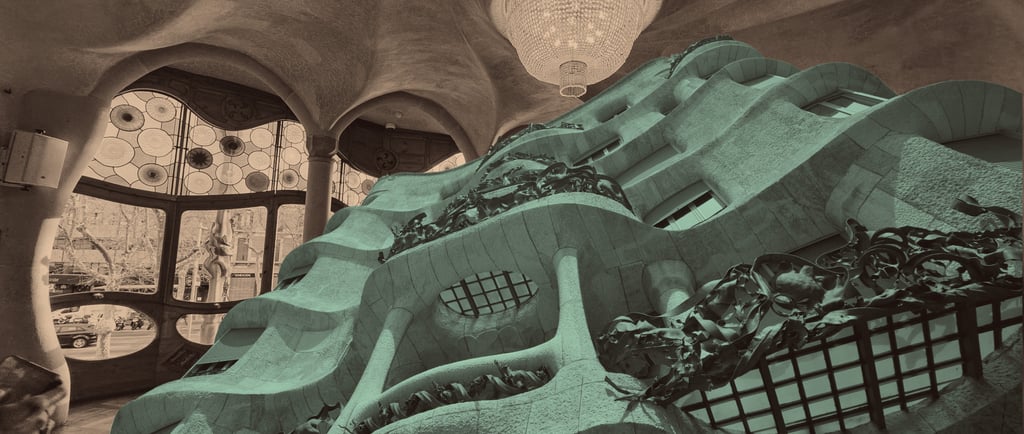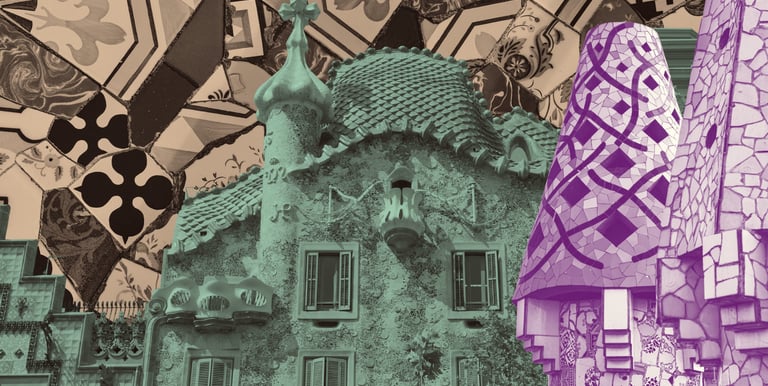Casa Mila: 10 Fascinating Facts About Gaudí’s Iconic Masterpiece
Casa Mila (La Pedrera), designed by Antoni Gaudí, is one of Barcelona’s most captivating landmarks. This architectural gem showcases the essence of Catalan modernism and is a must-see site in Barcelona. Ready to learn more? Here are 10 fascinating facts about Casa Mila that reveal why it's a UNESCO World Heritage treasure.
Karolina K.
5/28/20253 min read


1. Casa Mila’s Nickname Was Originally an Insult
Locals once mocked Casa Mila’s appearance, calling it La Pedrera—Catalan for "The Quarry"—because of its rough, stone-like façade. Over time, the nickname stuck and has since become an affectionate moniker for the building.
2. No Straight Walls—Seriously
Gaudí believed that nature had no straight lines. That’s why Casa Mila has no flat load-bearing walls on its façade. The entire building flows in wave-like curves, often likened to ocean waves or the Montserrat mountains.
3. Nature Was Gaudí’s Blueprint
Gaudí once said, "Originality consists in returning to the origin—in other words, to nature."
Casa Mila is filled with natural motifs, from seaweed-shaped iron balconies to palm leaf carvings. The attic even resembles the rib cage of a giant animal.
4. Sculptural Chimneys Like No Other
The rooftop of Casa Mila is a world of its own. The surreal, sculptural chimneys are one of its most photographed features. Some say they resemble warriors or otherworldly sentinels guarding the city skyline.
5. Structurally Revolutionary for Its Time
Casa Mila used a skeleton-style structure with stone columns and steel beams. This design allowed for open-plan interiors, decades ahead of modern architectural trends. It offered more flexibility and broke from traditional load-bearing wall layouts.
6. Gaudí Fought for Casa Mila’s Design
The building process was anything but smooth. Gaudí battled the city over height regulations, clashed with the Milà family over finances and aesthetics, and was often ridiculed by the press. There was even a legal dispute between the architect and the client.
7. Natural Materials Only
Staying true to his philosophy, Gaudí used local limestone from Garraf, along with terracotta and broken ceramics. The stone was left unpainted to celebrate its raw beauty—something radical at the time.
8. Original Interiors Were Changed Posthumously
After Gaudí passed away in 1926, many of Casa Mila’s original interiors were replaced by Rosario Segimón, who preferred more conventional decor. Sadly, this erased much of Gaudí’s integrated interior design work.
9. Some Elements Were Preserved
Despite the renovations, some original elements survived. A large, built-in cupboard unit designed to complement the building’s columns is now preserved at the Museu Nacional d’Art de Catalunya (MNAC).
10. Casa Mila Was a Team Effort
Gaudí didn’t work alone. Architect Josep Maria Jujol assisted with various elements, and skilled artisans like Casas y Bardes and Casa Mañach contributed carpentry and hardware that added finesse to the final result.
✨Why Casa Mila Is Still Relevant Today✨
Casa Mila isn’t just a tourist attraction—it’s a living museum of innovation, organic design, and a reminder that pushing boundaries can lead to timeless beauty. Whether you're drawn to its architectural genius, historical layers, or visual poetry, Casa Mila in Barcelona is a must-see destination that continues to inspire.
✨Plan Your Visit to Casa Mila✨
Ready to experience Gaudí’s vision firsthand? Be sure to book your Casa Mila tickets in advance, especially during peak season. Don’t miss the rooftop at sunset—it’s pure magic.
✨Final Word: Casa Mila Is a Gaudí Gem You Can’t Miss✨
Whether you’re an architecture lover, history buff, or curious traveler, Casa Mila offers more than just aesthetics—it’s a story of ambition, nature, and imagination that has stood the test of time.
Keywords: Casa Mila, Barcelona, Gaudí, La Pedrera, architecture, UNESCO, Gaudí masterpieces
Check our tours
Find out more about Gaudi from our art expert guide on private tour in Barcelona
Barcelona Highlights: Private Guided Walking Tour
Explore Barcelona’s most iconic neighborhoods and hidden gems on a private walking tour led by a passionate local expert. This journey takes you through vibrant streets, legendary landmarks, and centuries of history—where every corner has a story, and every story has heart.
Key Benefits:
Personalized experience – Private tour tailored to your pace and interests
Expert local guide – Discover the untold history behind Barcelona’s most famous sites
Iconic stops – From Gaudí’s architecture to the Gothic Quarter and La Rambla
Cultural depth – Go beyond the surface and uncover the city’s true character
Perfect for first-timers or returning travelers, this tour is your key to Barcelona’s past, present, and magic.
Barcelona: Casa Batlló & Casa Milà Private Guided Tour
Step into the fantastical world of Antoni Gaudí with a private guided tour through two of his greatest masterpieces—Casa Batlló and Casa Milà.
Key Benefits:
Skip-the-line access – Enjoy priority entry to both iconic buildings
Expert private guide – Dive into Gaudí’s symbolism, techniques, and inspirations
Architectural insight – Learn why these buildings sparked admiration and controversy
Visual wonder – Explore rooftops, staircases, and interiors like you’ve never seen
🎫 Includes Casa Batlló (Blue Ticket) & Casa Milà (La Pedrera Essential) entry tickets
Gaudí didn’t just build houses—he sculpted dreams. Now’s your chance to step inside them.
Contact
Contact us via email:
Subscribe to our newsletter!
office@tellmemoretravel.com
© 2025. All rights reserved.




